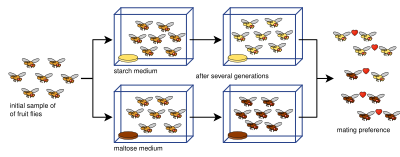Drosophila pseudoobscura
Drosophila pseudoobscura is a species of fruit fly, used extensively in lab studies of the genetics of natural populations.
It was first used by Theodosius Dobzhansky and his colleagues. They collected samples from populations in western North America and Mexico, and grew them in 'population cages' in the laboratory. They were interested in natural selection, genetic drift, and other aspects of population genetics.[1][2][3]

In 1989 Diane Dodd gave laboratory populations of D. pseudoobscura two different food types, starch and maltose. They rapidly evolved into two distinct groups after only eight generations with the different foods. As the two groups both showed a strong preference for mating with their own type, this was claimed as an example of speciation by reproductive isolation.[5] Dodd's experiment has been repeated by others, and works with other kinds of fruit flies and foods.[6]
In 2005, D. pseudoobscura was the second Drosophila species to have its genome sequenced, after Drosophila melanogaster.[7]
References
[change | change source]- ↑ Dobzhansky T. 1970. Genetics of the evolutionary process. Columbia University Press, New York.
- ↑ Dobzhansky T. 1981. Dobzhansky's Genetics of natural populations I-XLIII. R.C. Lewontin, J.A. Moore, W.B. Provine & B. Wallace, eds. Columbia University Press, New York. (reprints the 43 papers in this series, all but two of which were authored or co-authored by Dobzhansky)
- ↑ Dobzhansky, T.; Pavlovsky, O. (1957). "An experimental study of interaction between genetic drift and natural selection". Evolution. 11 (3): 311–319. doi:10.2307/2405795. JSTOR 2405795.
- ↑ "Dodd's publication" (PDF). Archived from the original (PDF) on 2013-07-25. Retrieved 2010-12-27.
- ↑ Dodd D.M.B. (1989). "Reproductive isolation as a consequence of adaptive divergence in Drosophila pseudoobscura" (PDF). Evolution. 43 (6): 1308–1311. doi:10.1111/j.1558-5646.1989.tb02577.x. PMID 28564510. S2CID 27685383. Archived from the original (PDF) on 2008-12-17. Retrieved 2010-12-16.
- ↑ Kirkpatrick M. & Ravigné V. (2002). "Speciation by natural and sexual selection: models and experiments". The American Naturalist. 159: S22–S35. doi:10.1086/338370. PMID 18707367. S2CID 16516804.
- ↑ S. Richards, Y. Liu; et al. (2005). "Comparative genome sequencing of Drosophila pseudoobscura: Chromosomal, gene, and cis-element evolution". Genome Research. 15 (1): 1–18. doi:10.1101/gr.3059305. PMC 540289. PMID 15632085.